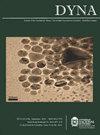Evidence-based practice among doctors in specialty training in a pediatric hospital in Peru
Q3 Engineering
引用次数: 0
Abstract
The purpose of this study is to determine the use of evidence-based practice among doctors in specialty training at Instituto Nacional del Niño-San Borja in Lima, Peru. (INSN-San Borja). A total of 200 doctors in paediatric specialty training were included in this cross-sectional study. The Health Sciences Evidence-Based Practice (HS-EBP) questionnaire was performed to assess the use of evidence-based clinical practices. The questionnaire has five dimensions: “Beliefs and attitudes” (D1), “Results from scientific research” (D2), “Development of professional practice” (D3), “Assessment of results” (D4), and “Barriers and facilitators” (D5). Each of the five HS-EBP questionnaire dimensions had a median score of 107, 107, 79, 88, and 77, respectively. The ranges of possible scores in each dimension were as follows: from 12 to 120 in D1, D4, and D5; from 14 to 140 in D2; and from 10 to 100 in D3. This study shows that doctors in specialty training at the INSN-San Borja obtained median scores over the mean of possible scores in each of those dimensions, with a lower score in D5 (Barriers and facilitators). This shows that these doctors use evidence-based practice, however they consider there are barriers for its application. According to our observations, the main barrier is the lack of available time due to other clinical commitments.秘鲁一家儿科医院专业培训医生的循证实践
本研究的目的是确定在秘鲁利马国立医院Niño-San博尔哈专业培训的医生中使用循证实践。(INSN-San博尔哈)。本横断面研究共纳入200名接受儿科专科培训的医生。采用健康科学循证实践问卷(HS-EBP)评估循证临床实践的使用情况。问卷有五个维度:“信念与态度”(D1)、“科研成果”(D2)、“专业实践发展”(D3)、“成果评估”(D4)、“障碍与促进因素”(D5)。HS-EBP问卷五个维度的中位数得分分别为107、107、79、88和77。各维度可能得分范围为:D1、D4、D5为12 ~ 120分;D2的14至140;D3从10到100。这项研究表明,在INSN-San Borja接受专业培训的医生在这些维度上的得分中位数都超过了可能得分的平均值,在D5(障碍和促进因素)上的得分较低。这表明这些医生使用循证实践,但他们认为应用有障碍。根据我们的观察,主要障碍是由于其他临床承诺而缺乏可用时间。
本文章由计算机程序翻译,如有差异,请以英文原文为准。
求助全文
约1分钟内获得全文
求助全文
来源期刊

Dyna-Colombia
工程技术-工程:综合
CiteScore
1.30
自引率
0.00%
发文量
0
审稿时长
4-8 weeks
期刊介绍:
The DYNA journal, consistent with the aim of disseminating research in engineering, covers all disciplines within the large area of Engineering and Technology (OECD), through research articles, case studies and review articles resulting from work of national and international researchers.
 求助内容:
求助内容: 应助结果提醒方式:
应助结果提醒方式:


